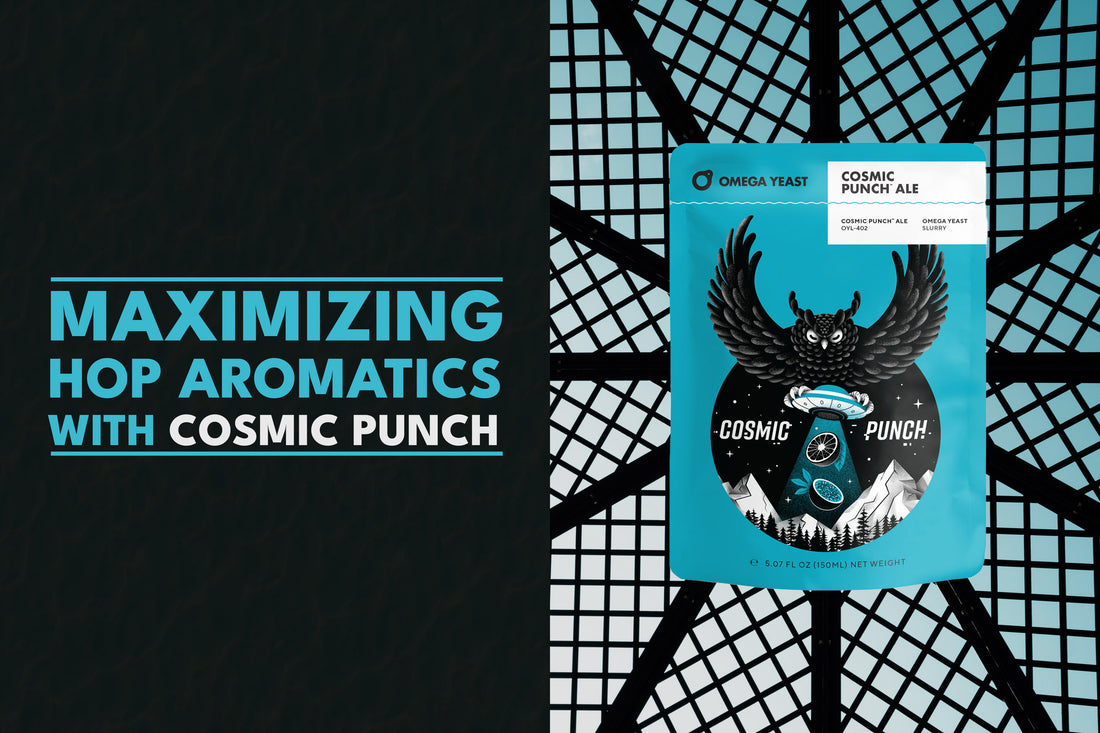
A few years ago we started carrying liquid yeast from Omega Yeast in Chicago. What attracted us to them at first was they carried Kveik strains, which have been a boon for homebrewers without temperature control all over the world. (I cover the whys and hows of Kveik here).
We’re always trying to keep the freshest product in stock and Omega’s location meant we could buy smaller quantities of yeast and have it shipped to the store faster. We’ve also been really impressed with their innovations in new yeast strains, hybrid strains and modified strains. They have remained at the forefront of brewing yeast technology and we are happy to be along for the ride. Omega’s most recent creation, Cosmic Punch takes their innovations just a little further and while we’ve highlighted it before, we wanted to double back and try to maximize the effects we’d get from its unique thiol-generating aspects.
First, we’ll need some background. As brewers, we know that along with adding bitterness to beer from the isomerization of alpha acids during the boil, hops also provide aroma. There are many aromatic oils in the form of terpenes in most hop varieties, all of them quite volatile. This is why we will add hops at flame out, or whirlpool in the kettle, so as to not boil them off. We also add hops post fermentation, called dry hopping, to add more of those lovely aromatic compounds. These compounds can give us the aromas we’ve come to associate with NEIPA styles (e.g. passionfruit, guava, grapefruit, “tropical”). In addition to terpene aromatics there are also compounds called thiols in hops.
We’ve only recently begun to really understand how we can release those aromatic compounds, called thiols (or mercaptans) in amounts that have a significant effect on our perception of aroma. Thiol compounds exist in two forms, the first being “free” thiols, which are highly aromatic and volatile compounds. Many of the Southern hemisphere hops are high in free thiols, and their “free” status makes them easy for brewers to drop in a brew and get the desired result.
The second type of thiol compound exists as a precursor thiol, non-aromatic thiol precursors that need to be transformed during the brewing process to release the aromatics. Some hop varieties are high in the thiol precursors, as is barley. The problem is getting these precursors transformed into “free” thiols. This is where yeast genetics come into play. There is a gene in many strains of brewing yeast that encodes a beta amylase enzyme that can release the thiol aromatics from the precursors. The problem is that this particular gene is usually not activated or the high nitrogen level of wort prevents it from activating. The good people at Omega found a yeast (through genetic modification) that would keep this gene on in all situations. They then added this active gene to their British Ale V strain and voila, a “thiolized” version was born.
So, now we have a yeast that can activate thiol precursors to bring out an abundance of tropical fruit aromas. Remember how we said both hops and barley malt contain these thiol precursors? Well, during the mash some of the precursors break down to the point that the Cosmic Punch can then thiolize them, but not as much as we’d prefer. It turns out that if you add certain hops that are high in thiol precursors to the mash (Cascade, Saaz, Hallertau Mittelfruh, Calypso) they help to create even more precursors from the barley.
It sounds crazy to add hops to the mash, right? So, as much as we love Omega, we were skeptical. We decided to brew two versions of our Sunrise IPA, both fermented with cosmic punch and brewed with the exact same ingredients except for one difference, one had mash hops (Cascade and Saaz) and one did not. At last night's beer swap we broke out both beers and did blind taste tests to see if anyone could tell which one was which. Everyone got it right because it was very obvious. Both versions had Citra and Simcoe whirlpool additions and Calypso and Cryo Mosaic dry hop additions, but the mash hop beers were far more aromatic. Tropical fruit aromas abounded, with guava, white wine, pineapple, and overall very bright fruit notes.
The mash hopped beer was only slightly more bitter than its counterpart. Omega recommends using mash hops at 30% of the ibus of what you would expect from your kettle additions. Our only other hot side hop additions were at flameout so there wasn’t much bitterness from the boil to begin with. It’s wild that a non-aromatic precursor could survive the boil and then be transformed into such pleasant aromatics by the yeast. I for one am a believer, and I am looking forward to other strains from Omega that have been thiolized.
We currently have two recipes that were constructed for Cosmic Punch’s thiol transformation properties, Sunrise IPA and Sgt Bitters Juicy Hops Club IPA (I know, the name’s a mouthful). You can make these beers with a different strain of yeast, but if you do I would forgo the mash hopping. For more detailed information on how all of this works with Cosmic punch please visit Omega’s page.
Cheers to beer and science!John

